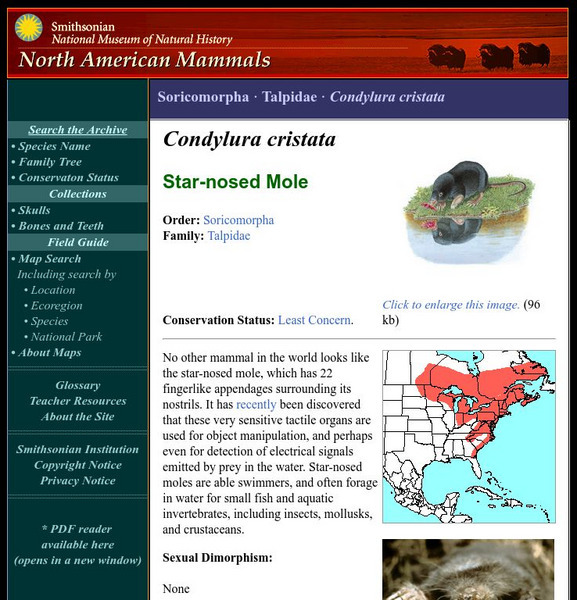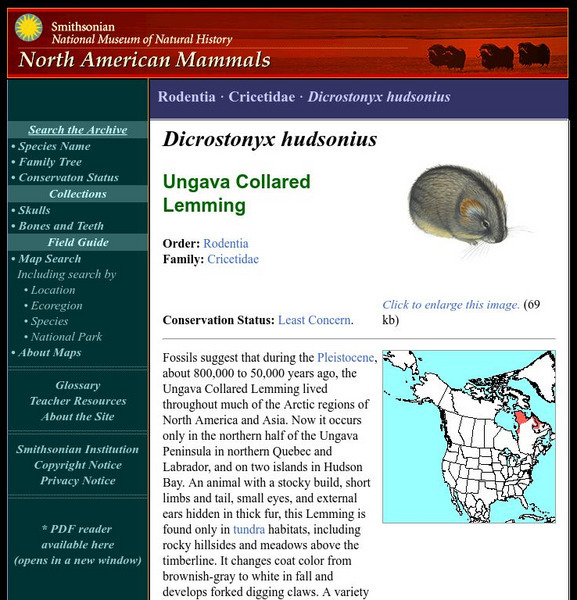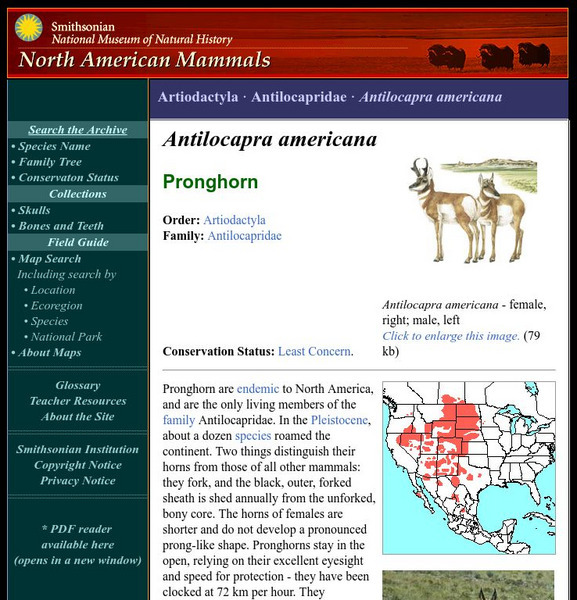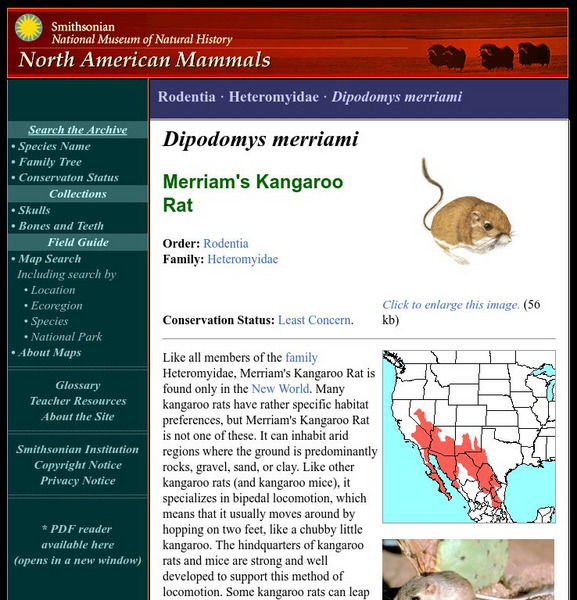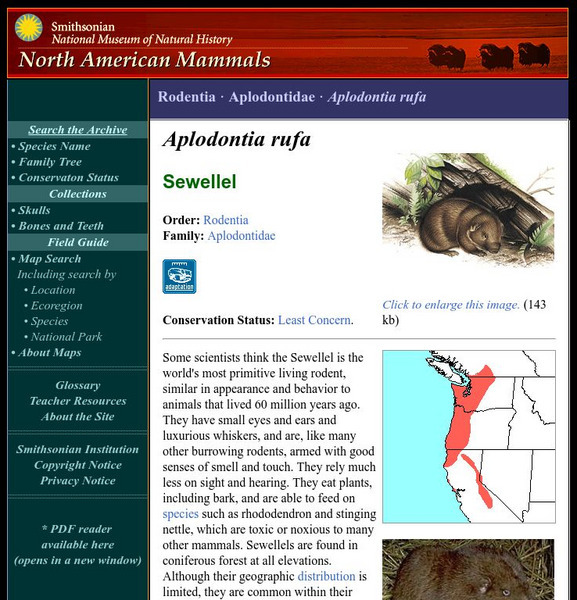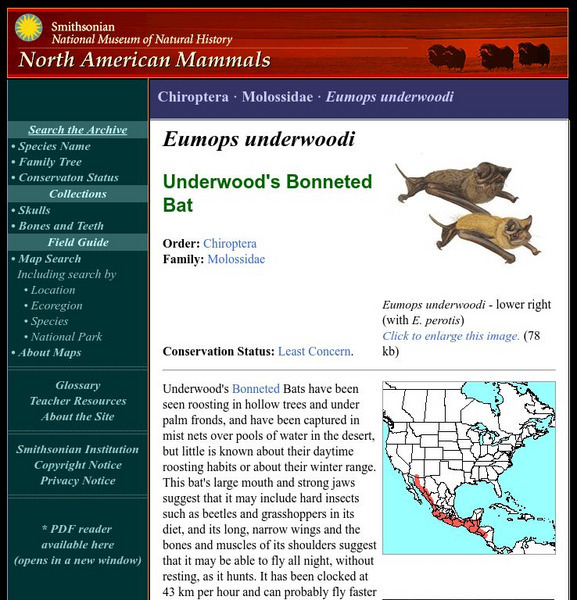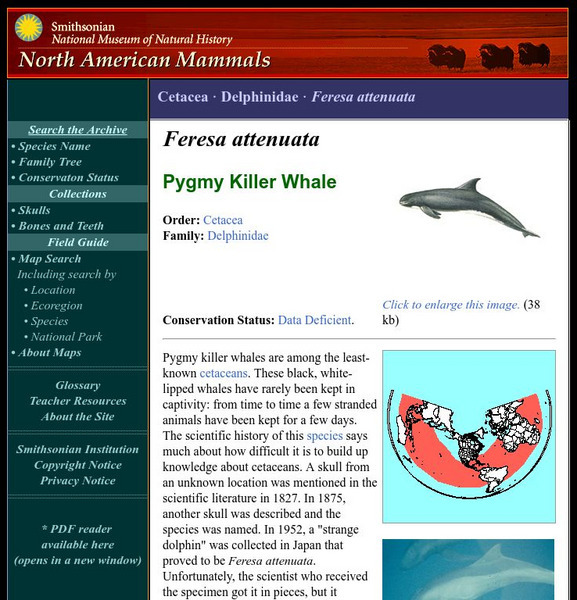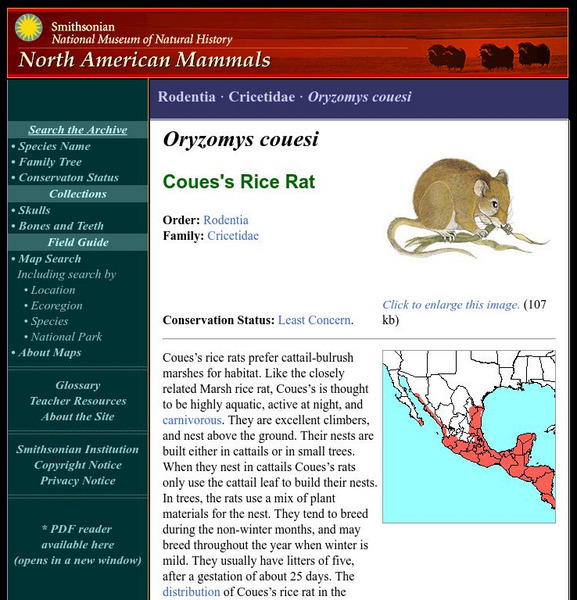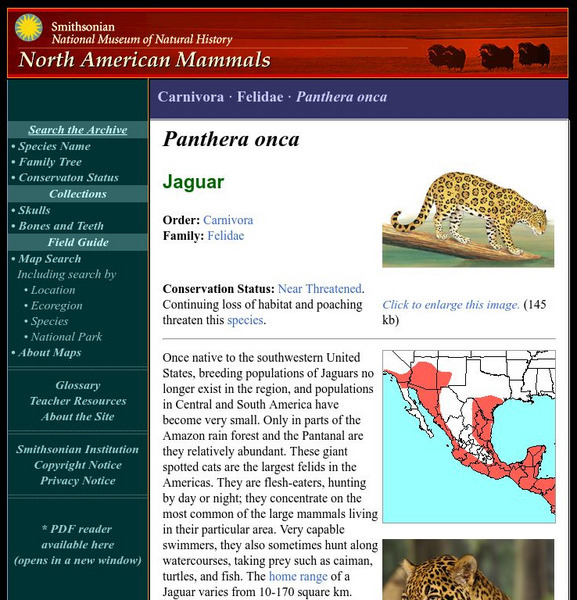Smithsonian Institution
National Museum of Natural History: American Mammals: Star Nosed Mole
No other mammal in the world looks like the star-nosed mole, which has 22 fingerlike appendages surrounding its nostrils. It has recently been discovered that these very sensitive tactile organs are used for object manipulation, and...
Smithsonian Institution
National Museum of Natural History: American Mammals: Texas Antelope Squirrel
Notable for its running speed, the Texas Antelope Squirrel has the longest hindlimbs and tail of any antelope squirrel. In the field, the squirrels are noticeable because of the way they carry the tail arched forward over the back. Learn...
Smithsonian Institution
National Museum of Natural History: American Mammals: Nine Banded Armadillo
The tank-like Nine-banded Armadillo's range has greatly expanded northward in the last 100 years. In the mid-1800s it was found only as far north as southern Texas; by the 1970s it lived in Oklahoma, Kansas, Missouri, and Tennessee; now...
Smithsonian Institution
National Museum of Natural History: American Mammals: Ungava Collared Lemming
Fossils suggest that during the Pleistocene, about 800,000 to 50,000 years ago, the Ungava Collared Lemming lived throughout much of the Arctic regions of North America and Asia. Now it occurs only in the northern half of the Ungava...
Smithsonian Institution
National Museum of Natural History: American Mammals: Northern Collared Lemming
Northern Collared Lemmings live farther north than any other rodent, making their homes on the Arctic tundra. They are among the few North American mammals to turn completely white in winter. Learn more about the Dicrostonyx...
Smithsonian Institution
National Museum of Natural History: American Mammals: Stephen's Kangaroo Rat
Stephen's Kangaroo Rat is endangered, chiefly due to habitat loss. It lives only in isolated populations in three counties of southern California. Learn more about the Dipodomys stephensi, more commonly known as a Stephen's Kangaroo Rat,...
Smithsonian Institution
National Museum of Natural History: American Mammals: Pronghorn
Pronghorn are endemic to North America and are the only living members of the family Antilocapridae. In the Pleistocene, about a dozen species roamed the continent. Learn more about the Antilocapra americana, more commonly known as a...
Smithsonian Institution
National Museum of Natural History: American Mammals: Panamint Kangaroo Rat
The Panamint Kangaroo Rat lives where vegetation includes creosote bush, cactus, yucca, juniper trees, and Joshua trees. A seed eater, this Kangaroo Rat makes particularly efficient use of its external cheek pouches, as it removes the...
Smithsonian Institution
National Museum of Natural History: American Mammals: Merriam's Kangaroo Rat
Like all members of the family Heteromyidae, Merriam's Kangaroo Rat is found only in the New World. Many kangaroo rats have rather specific habitat preferences, but Merriam's Kangaroo Rat is not one of these. Learn more about the...
Smithsonian Institution
National Museum of Natural History: American Mammals: Narrow Faced Kangaroo Rat
The Narrow-faced Kangaroo Rat, also known as the Santa Cruz Kangaroo Rat, occurs in central coastal California where annual rainfall is 75 cm and temperatures are moderate. It requires well-drained, deep soils and is often found on...
Smithsonian Institution
National Museum of Natural History: American Mammals: Ord's Kangaroo Rat
By occupying the short grass prairie of the Great Plains, and a variety of habitats where there are fine-textured, sandy soils, Ord's Kangaroo Rat has managed a truly enormous geographic distribution. The varied habitats that it occupies...
Smithsonian Institution
National Museum of Natural History: American Mammals: Texas Kangaroo Rat
Texas Kangaroo Rats live in only a few counties of north-central Texas, although the species was once also present in Oklahoma. They prefer to live where soils have a high percentage of clay. Learn more about the Dipodomys elator, more...
Smithsonian Institution
National Museum of Natural History: American Mammals: Sea Otter
The Sea Otter is the largest member of family Mustelidae, and the smallest marine mammal. Sea Otters are more aquatic even than seals and sea lions, because they mate and give birth in the water. Learn more about the Enhydra lutris, more...
Smithsonian Institution
National Museum of Natural History: American Mammals: North American Porcupine
North American Porcupines are large, slow-moving, tree-climbing rodents, protected from predators by their formidable quills. In winter, they eat the bark, phloem, and cambium of trees, particularly conifers. Learn more about the...
Smithsonian Institution
National Museum of Natural History: American Mammals: Mountain Beaver
Some scientists think the Mountain Beaver is the world's most primitive living rodent, similar in appearance and behavior to animals that lived 60 million years ago. They have small eyes and ears and luxurious whiskers, and are, like...
Smithsonian Institution
National Museum of Natural History: American Mammals: North Atlantic Right Whale
Northern right whales were hunted for at least 800 years until they became so rare that it was no longer commercially viable to hunt them. Biology made them and southern right whales the "right" whales to hunt, especially when whaling...
Smithsonian Institution
National Museum of Natural History: American Mammals: Underwood's Mastiff Bat
Underwood's mastiff bats have been seen roosting in hollow trees and under palm fronds, and have been captured in mist nets over pools of water in the desert, but little is known about their daytime roosting habits or about their winter...
Smithsonian Institution
National Museum of Natural History: American Mammals: Wagner's Mastiff Bat
Wagner's mastiff bat is considered endangered by the state of Florida, where habitat destruction and the use of pesticides may be contributing to its decline. It is a medium-sized bat with long, narrow wings. Learn more about the Eumops...
Smithsonian Institution
National Museum of Natural History: American Mammals: Pygmy Killer Whale
Pygmy killer whales are among the least-known cetaceans. These black, white-lipped whales have rarely been kept in captivity: from time to time a few stranded animals have been kept for a few days. Learn more about the Feresa attenuata,...
Smithsonian Institution
National Museum of Natural History: American Mammals: Southeastern Pocket Gopher
Equipped for a subterranean life, the Southeastern Pocket Gopher's muscular front legs, thick-set front body, massive claws on its front feet, small eyes and ears, and incisors protruding beyond the lips are obvious adaptations to life...
Smithsonian Institution
National Museum of Natural History: American Mammals: Coues's Rice Rat
Coues's rice rats prefer cattail-bulrush marshes for habitat. Like the closely related Marsh rice rat, Coues is thought to be highly aquatic, active at night, and carnivorous. Learn more about the Oryzomys couesi, more commonly known as...
Smithsonian Institution
National Museum of Natural History: American Mammals: Jaguar
Once native to the southwestern United States, breeding populations of Jaguars no longer exist in the region, and populations in Central and South America have become very small. Only in parts of the Amazon rainforest and the Pantanal...
Smithsonian Institution
National Museum of Natural History: American Mammals: Eastern Gray Squirrel
The adaptable, omnivorous, diurnal Eastern Gray Squirrel is the native American mammal people most frequently see east of the Mississippi River. It prefers to den inside trees, but will construct large nests of leaves in the canopy if...
Smithsonian Institution
National Museum of Natural History: American Mammals: Eastern Fox Squirrel
Eastern Fox Squirrels have long, foxtail-like tails, which they flick when they are excited. They and Eastern Gray Squirrels are alike in many ways. Learn more about the Sciurus niger, more commonly known as an Eastern Fox Squirrel, in...
